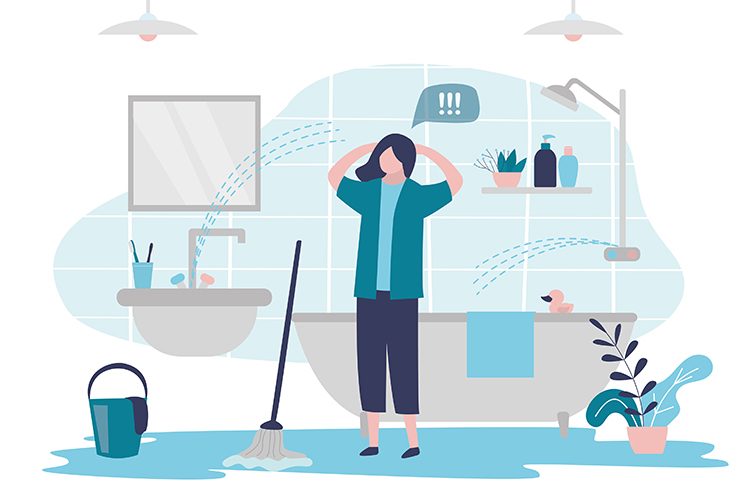Handling After-Hour Emergency Calls
Develop a system with CSRS and techs to determine which calls are truly emergencies and require a service call after business hours.

As a plumbing, heating and cooling contractor, I am sure you have encountered consumers calling you after hours for emergencies. To address these emergency calls, you need to set up a system that allows you to receive the call, contact the consumer and remedy the situation.
PHC contractors who only do new construction might not feel they need to address emergency calls, and many don’t. However, when the water cascades from a broken pipe those contractors just installed, someone must tend to the problem’s immediacy.
If those contractors do not, future work from those who contracted with them for the new construction project could be nonexistent.
PHC service contractors must tend to the emergency to keep the consumer as a client.
Therefore, someone must be on call to answer the consumer’s call. This can be handled by engaging an outside answering service to take the call and dispatch it to the technician on call. The problem with this method is that a certain amount of time is lost between the outside answering service taking the call and the technician receiving it.
During that lost time, an impatient and nervous consumer might be calling other contractors. In that instance, your technician might have his life interrupted without cause when he arrives at the consumer’s location and finds another contractor addressing the situation. And that presents yet another problem — unhappy technicians.
Another method would be to forward the call directly to the technician on call. However, the interruption of the technician’s life would still exist, and the number of interruptions would increase since the technician could be answering calls all night long. This would give you a very tired technician when the regular workday would begin.
You could hire a technician who only covers a night shift. However, the cost to do this could be prohibitive compared to the amount of money that might be brought into your business when addressing after-hour emergency calls.
Understanding an ‘Emergency’
As a PHC service contractor, I devised a system to mitigate the problems associated with these emergency call pitfalls.
If you have managers, as I did, the system works. If you are a one-person operation, you are the manager, but it would also work.
Step 1 is to know and understand the definition of the word emergency. Merriam-Webster defines an emergency as an unforeseen combination of circumstances or the resulting state that calls for immediate action; and an urgent need for assistance or relief.
The medical field addresses emergency health situations by implementing triage protocols. Merriam-Webster defines triage as the sorting of patients (as in an emergency room) according to the urgency of their need for care and the assigning of priority order to projects on the basis of where funds and other resources can be best used, are most needed or most likely to achieve success.
Since PHC contractors are doctors of buildings, it seems wise to follow a practice used by professionals who deal with life-and-death situations when assessing the status of emergencies.
Step 2 is to ask the consumer calling with the emergency what the emergency is. Then, ask when they first noticed the problem. Most consumers will answer the question honestly. If they say it happened yesterday or four hours ago, the need is not urgent since it didn’t require immediate action, so it is not an emergency. This situation is an inconvenience.
Now, since the call taker cannot instantly appear at the consumer’s location, a calm and cool technician on the phone can ask questions that will alleviate the panic associated with the emergency, whether actual or imagined.
Sometimes, for plumbing situations, the first thing to do is simply shut off the water to the area, whether it be the whole building or a fixture. Then, the urgent need for immediate action would be over, and the situation can be handled during regular business hours when the need for materials to remedy the situation can be attained.
If this is the case, you can tell the consumer that you will be there first thing in the morning when you can access the materials you need. You can explain that the amount they will pay you will be less than coming out in the middle of the night. I found consumers who were panicking appreciated this approach because it was only common sense and would cost them less.
If it’s a no-heat call on an extremely frigid night, calmly asking questions to give you an insight as to whether you will be able to help them after regular business hours will help you get the job done and satisfy their needs.
By keeping an inventory of commonly replaced heating parts in stock, you can rectify many common problems.
If you don’t have the material in the middle of the night, going out and telling them you can’t help them until the start of the regular workday because you will need parts not available at the time of the call will only serve to annoy both the consumer and the technician.
Regarding air-conditioning inconveniences: in my opinion, since people used to live without air conditioning for many years, the urgency of an air-conditioning malfunction doesn’t seem to me to be an urgent need requiring immediate action.
Lesson Learned
At this point, after following Steps 1 and 2, you will have reduced the number of calls requested after regular business hours. To further lower the number of after-hour calls, you can initiate a system that I, as a PHC service contractor, found to be successful.
I wouldn’t recommend this system to a new business trying to build strong clientele list. However, for established businesses that already have one, this control system can bring sanity to the business and allow it to control its operational costs and please the consumer.
In this system, depending upon circumstances, you may need to bend the system’s rules.
Step 3 is to start selling service agreements, offering consumers certain services that they may not have thought about at prices that make them seriously consider buying an agreement. As part of the service agreement, you can explain that the only consumers eligible for after-regular-business-hours (truly emergency) service are members of your service agreement program.
By doing this, you further control the chaos caused by after-hour calls while increasing the money brought into your business through service agreement sales. You can add that service agreement clientele receive priority service anytime because they are service agreement clients.
Allow me to explain the reason I implemented this system. I’m the type of guy who doesn’t like to make the same mistake twice. To keep from repeating mistakes, you must realize that a mistake has occurred and then implement a practice to keep you from making it again.
The first year I opened my PHC service business, I was the only technician. My wonderful wife answered the phones and I performed the services. I’m sure those of you who only have one tech (usually yourself) understand how very busy days can grate on your physical and mental health.
One very cold winter day, I started working at 7:30 a.m., going from one call to the next, nonstop. I returned home at 1:30 a.m. the next day. My wife was asleep and the phone calls were being tended to by my answering machine. As I walked into my house, the phone rang and the answering machine picked up the call.
A young father was on the phone desperately relating his tale of woe. His heat had gone out, and he had a one-week-old infant at home. Always being a person who liked to help others and being a young businessperson trying to build up my business, I picked up the phone and spoke with him.
You can be assured that I was physically spent after spending 18 straight hours serving consumer plumbing and heating needs. I asked him a few questions and realized he probably only needed a thermocouple replacement.
I knew I had the needed materials and explained that I could tend to him later in the day, but if he wanted me to come out then, it would cost him more money. He chose to have me come to his home as fast as possible.
So, I got back in my truck and headed out to his home. I replaced the thermocouple and checked the heating system to make sure all safeties were functioning, got paid, and returned home to get a few hours of sleep before starting on service calls at 7:30 a.m. I was beat.
By the time noon came, I was having lunch at a local diner frequented by many plumbers. As I sat there trying to eat my lunch without falling asleep in my soup, I heard a familiar gregarious voice call out: “Richie, thanks for taking care of my customer last night.”
After finally getting home and being able to sleep, I realized I had been taken advantage of, and that’s when I came up with the practice that only my good customers were entitled to after-hours “emergency service.”
You will need to make your own decisions regarding your business operation. I did and it helped me to maintain my sanity — and the sanity and morale of my technicians once I graduated to a multiperson operation.





